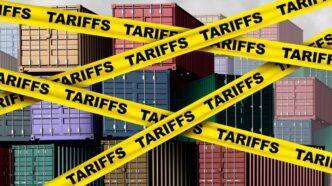Want to avoid tariffs in 2025? You’re not alone. Since the latest wave of U.S.-China tariffs launched on April 2, big names like Meta and Amazon have already felt the sting. Meta faces a potential $7 billion hit in ad revenue, while UPS is laying off 20,000 workers due to falling Amazon shipping volumes. But while the headlines focus on losses, some of the world’s biggest companies are quietly playing a smarter game behind the scenes.
They’re not breaking the rules. They’re just mastering them. And for startups looking to stay lean and competitive, there’s a lot to learn from their playbook on how to avoid tariffs—legally.
Inside the Legal Loopholes: How to Avoid Tariffs Like a Pro
Let’s start with the simplest option: manufacture in the U.S. Products made domestically dodge import duties entirely. No paperwork nightmares. No surprise hikes. And your shipping times drop dramatically.
But let’s be real—not every startup can find reliable or affordable U.S.-based suppliers. So what do you do when local sourcing isn’t viable? That’s when big brands lean into smart, legal strategies that turn tariffs into minor bumps rather than business-ending roadblocks.
These aren’t billionaire-only tactics. Startups can use them too—if they know where to look.
1. Tariff Engineering: Design With Purpose
Ever noticed the fuzzy sole on Converse Chuck Taylors? That’s not just for style—it’s strategy. By adding felt to more than half the sole, Converse reclassifies the shoe as a slipper. That little tweak slashes the import duty from 37.5% to just 3%.
Columbia Sportswear does the same. Their designers sneak in tiny waistline pockets on women’s blouses—not for utility, but to trigger a lower tariff classification.
Startups should take notes. A few well-placed features could cut your import costs dramatically.
2. The First Sale Rule: Cut Tariffs at the Source
Most importers pay tariffs on the price they pay their supplier. But what if you could base tariffs on what your supplier paid the manufacturer?
That’s the power of the first sale rule. If your supplier handles import duties under DDP (Delivery Duty Paid) terms, you can use the factory cost as your tariff baseline.
Say the manufacturer charges $10, your supplier charges you $20. With the right documentation, your tariffs could be calculated on $10, not $20. That’s a 50% savings—without changing your product or supply chain.
3. Duty Drawback: Claim Back Tariffs on Exports
If you re-export goods from the U.S. or destroy them without sale, you can reclaim up to 99% of the import duties you paid. It’s called a duty drawback, and it’s money most small businesses never realize they’re entitled to.
Example: You import 10,000 bottles, export 2,000 to Canada, and file a claim. That’s nearly $1,000 back in your pocket. You just need solid records and paperwork.
4. Change Country of Origin: The Assembly Advantage
Where your product is assembled can be more important than where it starts. Customs classifies items based on where they’re “substantially transformed.”
So if you import parts from China and assemble them in Mexico, you may legally label the item as Mexican-made. Thanks to trade agreements, that can mean significantly lower tariffs—or none at all.
Startups building hardware should pay close attention to this strategy. It’s a powerful way to shift your tariff exposure without starting from scratch.
5. Use Bonded Warehouses and FTZs
Bonded warehouses and Foreign Trade Zones (FTZs) let you delay or avoid paying tariffs on goods until they officially enter the U.S. market. If you export them instead? No tariffs at all.
Even better, if you modify products inside the FTZ, you might qualify for a lower tariff category based on the new item’s classification.
Startups that import in bulk—or need flexibility in where they sell—can benefit greatly from this system.
6. Unbundle Your Invoices: Pay Less With Smart Paperwork
Many businesses get hit with tariffs on the full invoice value, including non-taxable charges like software or design services. But those extras don’t always need to be tariffed—if you separate them correctly.
For instance, if your invoice breaks down like this:
- $80 for physical product
- $10 for software
- $10 for R&D
Customs might only apply tariffs on the $80. That’s a 20%+ savings just from smarter invoicing.
7. Shrinkflation: Cut the Fat, Not the Product
When margins get tight, even the biggest brands simplify. Restaurants trim portion sizes. Toy makers cut back on colors and materials. E-commerce brands remove freebies like packaging fluff or extra batteries.
Startups can do the same. Focus on what your customers actually value. Every dollar saved on product or shipping can help offset rising tariff costs.
Startups Can Use These Legal Plays Too
Tariffs don’t have to kill your business. While sourcing locally is still the cleanest fix, these strategies prove there are plenty of legal ways to fight back.
Here’s what startups should remember:
- Get creative with product design.
- Negotiate better terms with suppliers.
- Keep invoices clean and clear.
- Explore FTZs and duty drawbacks.
- Think globally, act strategically.
Big brands do it every day—and now you can too.













